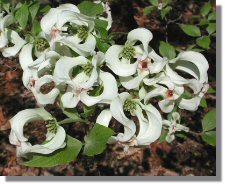Marc Montefusco
Frederick County Master Gardener Program
 Bradford pears are a variety of a pear native to Korea and China, Pyrus calleryana, which was first introduced to Western horticulture in 1908. The seedling which later became Pyrus calleryana "Bradford" was brought from Nanking
in 1919, but it wasn't until 1963 that the USDA introduced the variety commercially.
Bradford pears are a variety of a pear native to Korea and China, Pyrus calleryana, which was first introduced to Western horticulture in 1908. The seedling which later became Pyrus calleryana "Bradford" was brought from Nanking
in 1919, but it wasn't until 1963 that the USDA introduced the variety commercially.
The tree was supposed to be the perfect street tree, with profuse early bloom, a restricted pyramidal shape, and good fall color. So many landscapers, urban planners, and homeowners agreed with your assessment of this tree's beauty that today it can
be found almost everywhere.
 Your gardening friends snickered because they are snobs, but they are also referring to some of the weaknesses of the Bradford pear, which have only become apparent over time. A combination of plant physiology and physics makes the Bradford very
susceptible to wind and ice damage - in fact, it's rare to see an old planting that doesn't have at least one tree missing a substantial chunk of its limbs and trunk. The angle of the Bradford's branches is generally too narrow, and as the tightly-crowded branches grow in
girth, the tree begins to push itself apart. At the first strong wind or heavy ice storm, the tree self-destructs.
Your gardening friends snickered because they are snobs, but they are also referring to some of the weaknesses of the Bradford pear, which have only become apparent over time. A combination of plant physiology and physics makes the Bradford very
susceptible to wind and ice damage - in fact, it's rare to see an old planting that doesn't have at least one tree missing a substantial chunk of its limbs and trunk. The angle of the Bradford's branches is generally too narrow, and as the tightly-crowded branches grow in
girth, the tree begins to push itself apart. At the first strong wind or heavy ice storm, the tree self-destructs.
 Some people also object to the somewhat rank odor of the Bradford's flowers, and the modest mess created by its fruit. If you basically like the tree, but are concerned about its problems (or about your friend's snide comments) you might try another
cultivar called Cleveland Select, also known as Cleveland, Select, Chanticleer or Stone Hill. This cultivar is less susceptible to wind or ice damage, and it also hardens up a little earlier in the fall, making it less likely to be hurt by an early frost.
Some people also object to the somewhat rank odor of the Bradford's flowers, and the modest mess created by its fruit. If you basically like the tree, but are concerned about its problems (or about your friend's snide comments) you might try another
cultivar called Cleveland Select, also known as Cleveland, Select, Chanticleer or Stone Hill. This cultivar is less susceptible to wind or ice damage, and it also hardens up a little earlier in the fall, making it less likely to be hurt by an early frost.
If you have been intimidated right out of plating an ornamental pear, there are a few other spring-flowering trees that you might consider. Flowering crab apples are spectacular in bloom, although a few weeks later than the Bradford pear, and have
the added advantage (or disadvantage, depending on your viewpoint) of bearing colorful fruit, which can be ornamental in its own right, and which can provide food for wildlife during the winter. The fruit of the shadberry (also called Juneberry or serviceberry) will never
make it to winter: it's too tasty, whether you're a bird or an adventurous human. The graceful flowers are not born as profusely as those of the ornamental pears, but they have a lacy beauty all their own. Even the unfolding leaves are attractive, covered as they are in
fine silvery down, and the whole plant provides a good show in autumn, as those same leaves turn red. The scientific name of the of this genus is Amelanchier, and they 're more or less native to this area. A number of hybrids and cultivars have emerged - be sure to match
the size of the adult tree or shrub with your space.
|

Cornus florida |
The native dogwood, Cornus florida, is a magnificent spring-flowering tree, but it has fallen victim in our area to a fungal disease called anthracnose. There is a good deal or work going on to develop resistant varieties and hybrids. For now, Cornus
kousa, the Kousa dogwood, is a good substitute, and mature specimens display very attractive bark, which extends the period of appreciation right through winter. There are many named varieties: get a recommendation from someone you trust, or try to see plants in flower over
the next few months.
Another native, the Eastern redbud (Cercis canadensis), is also available as a number of cultivars, including the burgundy-leafed "Forest Pansy" and "Royal White," a variety which calls the whole "redbud" thing into question. Redbuds are easily
stressed, and will develop cankers and fungal wilts in this weakened state - give them good growing conditions and adequate water.
Even if you don't plant a flowering tree this spring, visit as many gardens, public and private, as you can.
There are also many books out there which will show you great options. After you have done your research and seen these plants in the landscape you can take advantage of the fall planting season and create your own custom show next spring.
Read other articles about tree care